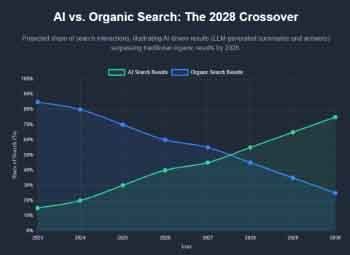We got it.
Thank you for contacting us.We’ll get back to you as soon as possible.
Why Your Website Conversion Rate is the Most Important Metric
By Doug Mansfield • 19 October 2025

The Critical Importance of Conversion Rates
As a business owner, you’re constantly tracking metrics. You watch your website traffic, your ad spend, your search rankings, and your social media engagement. But of all the numbers you could worry about, one stands above the rest as the true measure of your marketing effectiveness: your website conversion rate.
Defining the Win: What Actually Counts as a Conversion?
What is a "conversion"? It's not just a completed purchase. A conversion is any valuable, measurable action a visitor takes on your website. This could be:
- Placing a phone call
- Filling out a "contact us" form
- Signing up for your newsletter or a webinar
- Downloading a white paper or case study
- Completing a purchase
All of these actions are measurable. The most important thing is to know your numbers. For every 100 people who visit your website, how many take the specific action you want them to take?
If the answer is 1 out of 100, you have a conversion rate of 1%. In most industries, this would be considered low, though it does vary. For B2B lead generation, a 5% conversion rate is often considered good for a competitive industry. We’ve seen rates of 10% or higher, but that is less common.
It's generally easy to find a benchmark for your business by searching Google for topics like "industrial B2B website conversion rates," as this has been well-documented.
Why is This More Important Than Traffic?
Here’s the simple truth: your conversion rate is a direct measure of how effective all your marketing efforts will be.
Think about it. You can invest thousands in
Search Engine Optimization (SEO),
Generative Engine Optimization (GEO), or
paid advertising campaigns to drive more visitors to your site. But if your site can't convert those visitors, you're just pouring water into a leaky bucket.
Now, imagine you improve your conversion rate from just 1% to 2%. You have just
doubled your return on investment by doubling the leads or sales from the exact same amount of traffic. Your investment in SEO and advertising suddenly has twice the power.
This is why we focus on building a solid
Foundation first in our FADA® Marketing Framework. Your website is the core of that foundation, and its ability to convert is paramount.
5 Website Changes That Can Improve Conversion Rates
Sometimes, small changes to your website can make a big difference. Before you spend another dollar on ads, consider testing these five improvements:
- Clarify Your Call-to-Action (CTA): Is it perfectly clear what you want the visitor to do next? Vague buttons like "Submit" or "Learn More" are weak. Use strong, action-oriented language that clearly states the value. Instead of "Submit," try "Get Your Free Quote" or "Download the Guide Now." This is part of the 'Action' component of FADA®.
- Add Social Proof (Testimonials & Reviews): Customers want to know they're making a safe choice. Adding client testimonials, reviews, or logos of companies you’ve worked with builds immediate trust and credibility, answering the key question: "Why should I choose you?".
- Simplify Your Forms: Are you asking for a prospect's life story just for them to download a brochure? Every unnecessary field you add to a form increases friction and causes people to abandon it. Only ask for what is absolutely essential to move to the next step.
- Improve Page Load Speed: In 2025, speed is a feature. If your site takes more than a few seconds to load, visitors will leave before they even see your message. Optimizing images and code for speed is a technical change that has a direct impact on sales.
- Ensure Mobile-Friendliness (Responsive Design): A significant portion of your B2B and industrial audience is viewing your site on a phone, whether from the field, a job site, or just away from their desk. If your site is difficult to navigate on a mobile device, you are losing leads. Our websites are always designed for both desktop and mobile to ensure a seamless user experience.
How to Make Changes Effectively
For business owners who have a website they can't effectively manage, that is the place to start. You need the ability to test changes, often referred to as A/B testing, to discover what works and what doesn't.
Be careful to make logical, measured steps. Don't make too many changes at once or too frequently. If you change your headline, button color, and contact form all at the same time, you'll never know which change had an impact—for good or for bad.
There's a lot you can do on your own, but there is also a whole industry of tools that help business owners and marketing agencies optimize for conversion rates.
5 Reputable Conversion Rate Optimization (CRO) Tools:
- Google Analytics: The essential free tool for measuring your baseline. You can't improve what you don't measure.
- Hotjar (or Microsoft Clarity): These tools provide "heatmaps" and "session recordings" to show you visually where users are clicking, scrolling, and getting stuck on your site.
- Optimizely (or VWO): Powerful A/B testing platforms that allow you to show different versions of a page to different visitors and see which one performs better.
- Unbounce (or Leadpages): These are landing page builders designed specifically to create high-converting pages for your ad campaigns, separate from your main website.
- OptinMonster: A popular tool for creating and testing pop-ups, "exit-intent" offers, and other lead capture forms.
Your website should be a living document, never "perfected" and never without room for improvement. Careful, measured steps are the path to success—not sweeping changes made on a whim. This iterative improvement is how you turn your website from a digital brochure into a marketing engine that truly affects your bottom line.
A Note: Exceptions to the Rule
With all that said, this intense focus on website conversion rate isn't a universal rule for every single business. Your "most important metric" must be adjusted to your specific business model. For example, some e-commerce brands or service providers may conduct more direct business through social media channels than on their website, using platforms like Instagram Shopping or Facebook Messenger to make sales. Similarly, a business whose primary goal is broad brand awareness—not immediate leads—might be more focused on impressions, reach, and ad frequency. For a complex B2B company with a year-long sales cycle, focusing on a single "contact us" conversion might be less important than tracking a series of micro-conversions (like white paper downloads or webinar sign-ups) that indicate a prospect is moving through the sales funnel. The key is to identify the metric that most directly measures the success of your primary marketing goal. For most businesses seeking to generate leads and sales online, that metric remains the website conversion rate.
This blog post was written by the founder of Mansfield Marketing, Doug Mansfield.
- Visit Doug Mansfield's professional portfolio website.
- Connect with Doug Mansfield on LinkedIn.
Latest Posts














